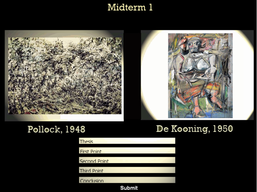Multimedia Projects
District Leadership Design lab Website (2013-16)
Entrepreneurship Resources (UW School of Business, 2013)

This site was created for Dr. Alan Leong in the Foster School of Business at the University of Washington. The site presents three video-based cases that are intended to advertise the Software Entrepreneurship course and provide advice to future students.
English Pronunciation for Non-native Speakers (Qualcomm, 2010)

For this project, I worked with a speech therapist to develop language lessons for non-native English speakers. We used interactive animations, instructional videos, and one-file PDF deployment to create a durable resource for internal and external clients.
The Big Q (Qualcomm, 2009)
WHAT DO INSTRUCTIONAL DESIGNERS DO?

The Big Q and the Case of the Missing Chips is a spoof of films noir meant to teach internal documentation groups about the role of training and instructional designers in the company. For this project, I created a screenplay and storyboard, conducted the principal photography with a digital SLR, recruited my teammates for voice-acting, narrated the script, and animated the film in Adobe Captivate 4.
The Inevitable room (SDSU, 2007)

The Inevitable Room was a Second Life-based course on Ageism in the medical profession. It was created to serve as an example of using a known method (coaching strategies) to solve a novel design problem (virtual coaching, or vCoaching).
This conversion of coaching to a virtual environment required an expanded and recursive design process for my team. We began to see the training as a linear, yet variable, experience. Users would act out predefined situations (as in real-life ageism coaching), but would be subject to more tactile limitations (such as a reduced-stature avatar, blurred ‘vision,’ and the appearance of an aged avatar). We pushed this idea further. Eventually, we built interaction in Second Life’s multi-user environment right into the activity. The final product is a multi-phase training simulation that allows users to experience the marginalization often felt by older people.
This conversion of coaching to a virtual environment required an expanded and recursive design process for my team. We began to see the training as a linear, yet variable, experience. Users would act out predefined situations (as in real-life ageism coaching), but would be subject to more tactile limitations (such as a reduced-stature avatar, blurred ‘vision,’ and the appearance of an aged avatar). We pushed this idea further. Eventually, we built interaction in Second Life’s multi-user environment right into the activity. The final product is a multi-phase training simulation that allows users to experience the marginalization often felt by older people.
Compare-It (SDSU, 2007)

Click to read a PDF of the wiki-report
Art history, as a field, requires that students become skilled at the process of comparison. During their education, students encounter
numerous tests wherein they must compare pairs of art objects that are separated by time and space. Professors prepare these exams with great care, as they deliberately select the pieces for the comparison. The chosen objects represent a principle, connection, or idea that the instructor expects the students to tease out of the two pieces. These comparisons require keen observation on the part of the student. They also require a broad understanding of the artistic, political, social, technological, and literary history of the pieces, as well as an eye for ambiguity.
CompareIt will help students improve their comparison skills, as well as help them study for their exams. In this game, students of Art History will compare pairs of objects that appear on their screen in an attempt to create an abstract order from apparent chaos. They must ask 'Why are these two paintings on my screen? What are the connections between them? How are they similar, how are they different?' while taking form, content, or historical context into account.
numerous tests wherein they must compare pairs of art objects that are separated by time and space. Professors prepare these exams with great care, as they deliberately select the pieces for the comparison. The chosen objects represent a principle, connection, or idea that the instructor expects the students to tease out of the two pieces. These comparisons require keen observation on the part of the student. They also require a broad understanding of the artistic, political, social, technological, and literary history of the pieces, as well as an eye for ambiguity.
CompareIt will help students improve their comparison skills, as well as help them study for their exams. In this game, students of Art History will compare pairs of objects that appear on their screen in an attempt to create an abstract order from apparent chaos. They must ask 'Why are these two paintings on my screen? What are the connections between them? How are they similar, how are they different?' while taking form, content, or historical context into account.
Try the Compare-it prototype by clicking on the box above (Requires Flash)
Art History Videos (SDSU, 2007)
|
|
The source material for these films comes from a famous article by Bernini scholar Joy Kenseth. With these images, Kenseth illustrated that one should not view Bernini’s Borghese statues frontally. Viewers should instead walk around the statues to view a story that unfolds in stone. She claimed that Bernini used theatrical tricks to create statues that show and hide narrative elements as one circles around them.
With these short clips, accompanied by audio narration, I converted her series of pictures of Bernini’s statues into a virtual “walk around” that visually communicates her ideas to the audience. This use of technology to convert one form of visual media (photographs) into another (movies) proved the most successful part of the project. It took advantage of the affordances of iMovie’s Ken Burns Effect to more truly capture the experience of viewing Bernini’s Borghese statues ‘in the round.’
|
